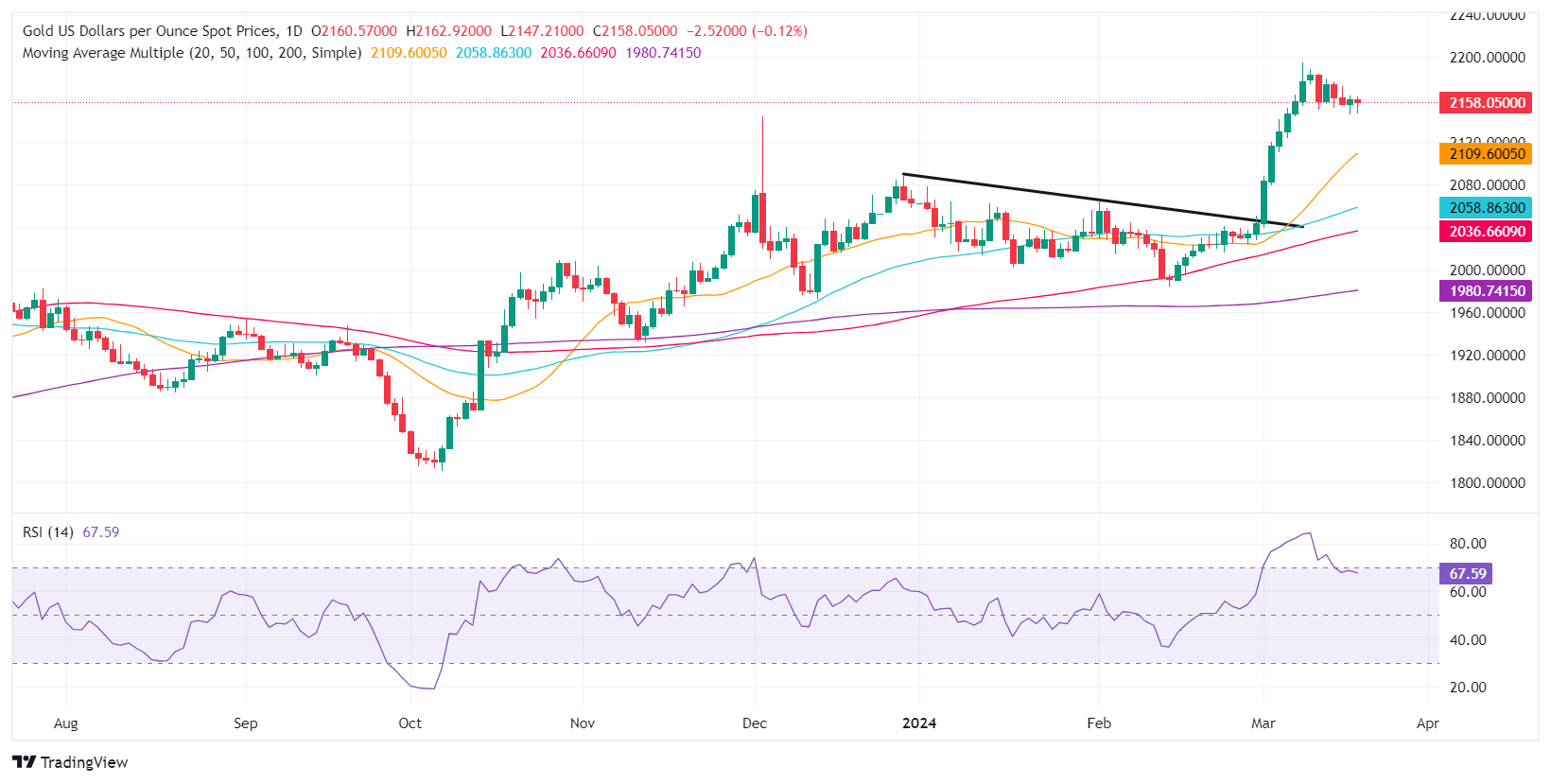Gold prices retreat amid strong US Dollar pre FOMC’s decision

- Gold is subdued amid a robust US Dollar in anticipation of the Fed’s monetary policy announcement.
- Traders are waiting for the Federal Reserve’s statement and economic forecasts.
- Concerns over potential adjustments in the Federal Funds Rate projections keep market sentiment cautious.
Gold prices fell late in the North American session on Tuesday amid a strong US Dollar but despite falling US Treasury bond yields. Market participants await the US Federal Reserve’s (Fed) monetary policy announcement on Wednesday, followed by a press conference by Fed Chair Jerome Powell. Meanwhile, XAU/USD prices are set to remain near $2,150 as traders remain uncommitted to posting fresh bets in favor or against the yellow metal.
The non-yielding metal remains subdued as traders await the Federal Open Market Committee (FOMC) decision. In addition to delivering its monetary policy statement, policymakers are expected to update their projections about the United States economy. Growing concerns that the Fed will reduce its estimates for the Federal Funds Rate (FFR) keep traders on edge.
Daily digest market movers: Gold holds to modest gains as US yields drop
- Tuesday’s US economic docket featured the release of Building Permits in February, which rose by 1.9% MoM from 1.489 million to 1.496 million. Meanwhile, Housing Starts for the same period saw a significant increase of 10.7%, surpassing the expected 8.2%.
- The US 10-year Treasury bond yield has fallen two-and-a-half basis points to 4.296%.
- The latest US economic data witnessed mixed readings in business activity, making it challenging to predict the pace of economic deceleration in the US. The labor market has shown signs of cooling, though the economy added more people to the workforce than expected while fewer people applied for unemployment benefits.
- Recent inflation data in the US showed that inflation on the consumer and producer side surprised to the upside, suggesting that inflation is stickier than expected, failing to break below the 3% threshold.
- Given the backdrop, Fed Chair Jerome Powell’s testimony at the US Congress earlier this month, suggesting the Fed would begin to cut borrowing costs, were justified. However, last week’s inflation figures and Retail Sales data triggered a repricing of Fed rate cut bets, aligning with the US central bank’s view of 75 basis points of easing toward the end of 2024.
- According to the CME FedWatch Tool, expectations for a June rate cut stand at 58%, down from 72% a week ago.
Technical analysis: Gold buyers take a breather below $2,170
XAU/USD price has stabilized ahead of the FOMC decision, sitting above the December 4 high of $2,146.79, the first support level. A dovish tilt by the Fed could pave the way for a recovery toward the March 8 high of $2,195.15, followed by the $2,200 mark.
On the other hand, if Gold spot price tumbles below $2,150, look for a breach below December’s 3 high, exposing the March 6 low of $2,123.80, followed by $2,100.
Gold FAQs
Gold has played a key role in human’s history as it has been widely used as a store of value and medium of exchange. Currently, apart from its shine and usage for jewelry, the precious metal is widely seen as a safe-haven asset, meaning that it is considered a good investment during turbulent times. Gold is also widely seen as a hedge against inflation and against depreciating currencies as it doesn’t rely on any specific issuer or government.
Central banks are the biggest Gold holders. In their aim to support their currencies in turbulent times, central banks tend to diversify their reserves and buy Gold to improve the perceived strength of the economy and the currency. High Gold reserves can be a source of trust for a country’s solvency. Central banks added 1,136 tonnes of Gold worth around $70 billion to their reserves in 2022, according to data from the World Gold Council. This is the highest yearly purchase since records began. Central banks from emerging economies such as China, India and Turkey are quickly increasing their Gold reserves.
Gold has an inverse correlation with the US Dollar and US Treasuries, which are both major reserve and safe-haven assets. When the Dollar depreciates, Gold tends to rise, enabling investors and central banks to diversify their assets in turbulent times. Gold is also inversely correlated with risk assets. A rally in the stock market tends to weaken Gold price, while sell-offs in riskier markets tend to favor the precious metal.
The price can move due to a wide range of factors. Geopolitical instability or fears of a deep recession can quickly make Gold price escalate due to its safe-haven status. As a yield-less asset, Gold tends to rise with lower interest rates, while higher cost of money usually weighs down on the yellow metal. Still, most moves depend on how the US Dollar (USD) behaves as the asset is priced in dollars (XAU/USD). A strong Dollar tends to keep the price of Gold controlled, whereas a weaker Dollar is likely to push Gold prices up.
